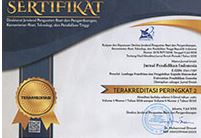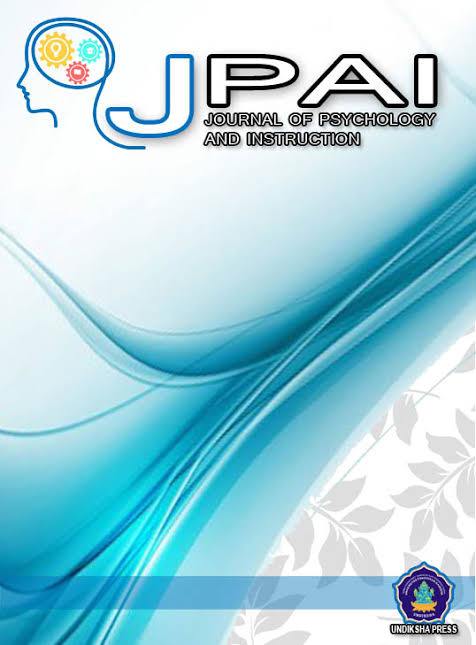STUDENT’S PERCEPTION OF SCHOOL’S IMAGE AND LEARNING MOTIVATION
DOI:
https://doi.org/10.23887/jpai.v3i2.21398Keywords:
Motivation, School’s Image, Student’s PerceptionAbstract
The aim of this study is to find out the relation between student’s perception of school’s image and learning motivation. It is hypothetized that there was a positive relationship between student’s perception of school’s image and learning motivation. Around 61 eighth grader students in class C and D at MTs Negeri 10 Sleman. This research used Learning Motivation scale and Student’s Perception of School’s Image scale. Product Moment correlation by Pearson was used to analyze the data. The result of the study showed that there was significantly positive relation between student’s perception of school’s image and learning motivation (rxy = 0.292; p < 0.05). This result indicated that the study’s hypothesis was accepted. The effective contributions of student’s perception of school’s image to learning motivation was 8.6 % (R2 = 0.086).
References
Alifahmi, H. (2008). Marketing Communications Orchestra. Harmonisasi Iklan, Promosi, dan Marketing Publik Relations. Bandung: Examedia Publishing.
Alizamar, & Couto. (2016). Psikologi Persepsi dan Desain Informasi: Sebuah Kajian Psikologi Persepsi dan Prinsip Kognitif untuk Kependidikan dan Desain Komunikasi Visual. Yogyakarta: Media Akademi.
Azwar, S. (2013). Penyusunan Skala Psikologi. Yogyakarta: Pustaka Pelajar.
Azwar, S. (2014). Reliabilitas dan Validitas, Edisi 4. Yogyakarta: Pustaka Pelajar.
Brophy, J. (2004). Motivating Students to Learn, 2nd Edition. New Jersey: Lawrence Erlbaum Associates.
Dalyono. (1996). Psikologi Pendidikan. Jakarta: Rineka Cipta.
Davis, S. M. (2000). Brand Asset Management : Driving Profitable Growth Through Your Brand. . California: Jossey-Bass, Inc. Publishers.
Dhamayanti, R. (2013). Tingkat Prestise dan Persepsi Siswa pada Citra Sekolah dan Pengaruhnya terhadap Motivasi Belajar Siswa. Jurnal Pendidikan Akuntansi Vol. 1 No. 3.
Dimyati, & Mudjiono. (2009). Belajar dan Pembelajaran. Jakarta: PT Rineka Cipta.
Fahrurrozi. (2015). The Effectiveness of The Perception about Product, Promotion, and Price to Increase School Image and Loyalti of Parents (Study on Islamic Early Childhood Education Institutions in Semarang). Madania Vol. 19, No. 2.
Frandsen, A. N. (1967). Educational Psychology 2nd Edition. USA: Mc.Graw Hill.
Gage, N. L., & Berliner, D. C. (1984). Educational Psychology. Boston: Houghton. Mifflin Company.
Giota, J. (2001). Adolescents Perception of School and Reasons for Learning. Sweden: Acta Universtatis Gothoburgensis.
Hadi, S. (2015). Metodologi Riset. Yogyakarta: Pustaka Pelajar.
Halimah, A. (2009). Pengaruh Persepsi Siswa tentang Citra Sekolah Terhadap Motivasi Belajar Siswa Kelas XI Jurusan Akuntansi di SMK Negeri 2 Blitar. Skripsi. Tidak Diterbitkan. Malang: Fakultas Ekonomi Universitas Negeri Malang.
Hidayat, A., & Machali, H. (2012). Pengelolaan Pendidikan. Konsep, Prinsip, dalam Mengelola Sekolah dan Madrasah. Yogyakarta: Kaukaba.
Holfve-Sabel, & Gustafsson. (2005). Attitudes towards school, teacher, and classmates at classroom and individual levels: An application of two-level confirmatory factor analysis. Scandinavian Journal of Educational Research, 49, 187-202.
Idayanti. (2015). Pengaruh Persepsi Siswa tentang Lingkungan Sekolah terhadap Motivasi Belajar Siswa Pada Mata Pelajaran IPS Kelas VIII SMP Negeri 40 Semarang. Skripsi. Semarang: Universitas Negeri Semarang.
Kotler, P. (2002). Manajemen Pemasaran Edisi Millenium (terjemahan: Hendra Teguh). Jakarta: Prenhallindo.
Kotler, P. (2008). Prinsip-Prinsip Pemasaran (terjemahan: Bob Sabran). Ed. 13. Jilid 1. Jakarta: Erlangga.
Maamarah, S., & Supramono. (2016). Strategi Peningkatan Mutu dan Citra (Image) Sekolah Dasar Negeri di Ungaran, Semarang. Jurnal Manajemen Pendidikan. 3, 115-130.
Maher, M. A. (2000). A structural model of attitudes towards school subjects, academic aspiration and achievement. Educational Psychology, 20, 75-85.
Mardiyana, R. (2014). Hubungan Persepsi Dan Sikap Dengan Motivasi Belajar Mahasiswa Semester III D-III Kebidanan Stikes Bina Sehat PPNI Mojokerto. Jurnal Penelitian Kesehatan Vol 11, No 2.
Mc.Clelland, D. C. (1987). Human Motivation. Cambridge: Cambridge University Press.
Nugent, T. T. (2009). The Impact of Teacher-Student Interaction on Student Motivation and Achievement. Orlando, Florida: University of Central Florida.
Passer, M. W., & Smith, R. E. (2008). Psychology: The Science of Mind and Behavior 4th Edition. New York: McGraw-Hill Companies, Inc.
Prabowo, H. (2012). Hubungan Antara Persepsi Lingkungan dan Fasilitas Praktik dengan Motivasi Belajar Peserta Didik pada Kompetensi Keahlian Teknik Kendaraan Ringan SMK Muhammadiyah 3 Yogyakarta. Skripsi. Yogyakarta: Universitas Negeri Yogyakarta.
Pradita, D. H. (2017). Pencitraan Sekolah dalam Upaya Meningkatkan Minat Peserta Didik Baru (Studi Kasus di SMA Muhammadiyah 2 Surabaya). Inspirasi Manajemen Pendidikan Vol. 1 No. 2.
Pratiwi, E. D. (2010). Pengaruh Persepsi dan Prestise Siswa pada Citra Sekolah terhadap Motivasi Belajar Ekonomi Siswa Kelas XI.IS di SMA Negeri 4 Kota Probolinggo. Skripsi. Tidak Diterbitkan. Malang: Fakultas Ekonomi Universitas Negeri Malang.
Radovan, M., & Makovec, D. (2015). Relations Between Students’ Motivation and Learning Environment. Center for Educational Policy Studies Journal, Vol.5 No 2.
Reynolds, D. (2001). World class schools: International perspectives on school effectiveness. Florence, KY: Routledge.
Robbins, S. (2003). Perilaku Organisasi, Jilid 1 (terjemahan: Tim Indeks). Jakarta: PT Indeks Kelompok Gramedia.
Ryan, R. M., & Deci, E. L. (2000). Intrinsic and Extrinsic Motivations: Classic Definition and New Directions. Contemporary Educational Psychology Vol.25, 54-67.
Ryan, R. M., & Deci, E. L. (2000). Self-Determination Theory and The Facilitation of Intrinsic Motivation, Social Development, and Well-Being. American Psychologist Vol.55 No.1, 68-78.
Santrock, J. (2008). Educational Psychology (3th Edition). New York: McGraw Hill Companies, Inc.
Sardiman, A. (2011). Interaksi dan Motivasi Belajar Mengajar. Jakarta: Raja Grafindo Persada.
Seifert, K. I., & Sutton, R. (2009). Educational Psychology 2nd Edition. Switzerland: Jacobs Foundation.
Slameto. (2010). Belajar dan Faktor-faktor yang Mempengaruhinya. Jakarta: Rineka Cipta.
Slavin, R. (2009). Educational Psychology: Theory and Practice 9td Edition. New Jersey: Pearson Education Inc.
Usher, A., & Kober, N. (2012). Student Motivation - An Overlooked Piece of School Reform. Center on Education Policy.
Walgito, B. (2004). Pengantar Psikologi Umum Edisi IV. Yogyakarta: Andi Offset.
Widhiarso, W. (2010). Uji Linearitas Hubungan. Manuskrip tidak dipublikasikan. Yogyakarta: Fakultas Psikologi Universitas Gadjah Mada.
Williams, K. C., & Williams, C. C. (2011). Five Key Ingredients for Improving Student Motivation. Research in Higher Education Journal, 104-122.
http://referensi.elsam.or.id/2014/11/uu-nomor-20-tahun-2003-tentang-sistem-pendidikan-nasional/ diakses pada tanggal 19 Agustus 2017 pukul 15.07 WIB.
http://mtsnegeribabadanbarudayu.blogspot.co.id/p/profil.html diakses pada tanggal 28 Oktober 2017 pukul 19.36 WIB.










